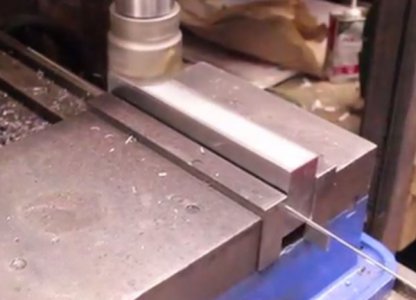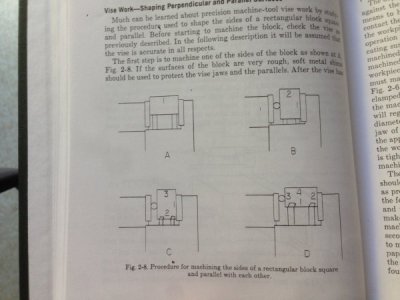-
Welcome back Guest! Did you know you can mentor other members here at H-M? If not, please check out our Relaunch of Hobby Machinist Mentoring Program!
You are using an out of date browser. It may not display this or other websites correctly.
You should upgrade or use an alternative browser.
You should upgrade or use an alternative browser.
What is this wire on the Vise Jaws?
- Thread starter oskar
- Start date
The wire will allow for any irregularities in the material. This way the stock will be flat to the fixed jaw. Thus allowing the top of the stock to be machined square with fixed jaw. Use this procedure till all sides are square to each other. You can use aluminum brass or steel for the wire about 1/8" diameter is usually sufficient to allow the wire to conform to the rough side of the material.
Hope this is as clear as mud. Maybe others could explain it in simpler terms.
Hope this is as clear as mud. Maybe others could explain it in simpler terms.
This technique is used to square up a piece of stock. Once you take a cut off your stock you place the fresh cut on the fixed jaw. When you place the piece of malubal wire in between the moving jaw and your work it allows the work piece to sit flat against the fixed jaw without your piece being parallel yet. Once you take your cuts and have two parallel sides the wire is not needed.
It’s there to take the irregularness out of the part so you can clamp in vise and it will be secure.
It’s there to take the irregularness out of the part so you can clamp in vise and it will be secure.
- Joined
- Apr 30, 2015
- Messages
- 12,250
I use a popsicle stick similarly- Jan and Dean would be proud
Here is another variation of using a round to hold an irregular piece of material. This on has the round axis in the vertical orientation.
http://www.frets.com/HomeShopTech/TechMill/RustySalvage/rustysalvage.html
http://www.frets.com/HomeShopTech/TechMill/RustySalvage/rustysalvage.html
- Joined
- Dec 27, 2013
- Messages
- 124
For the size of most of the small work I do, I use the solid copper wire from a standard 12 or 10 AWG romex cable. The ground is easiest, but the white and black are also easy to strip out. Easy to bend it to hold on the jaws. Professional machinists I know usually have a couple of larger ball bearings with one side ground a bit to use for one side of irregular work.
- Joined
- Nov 24, 2013
- Messages
- 268
For the size of most of the small work I do, I use the solid copper wire from a standard 12 or 10 AWG romex cable. The ground is easiest, but the white and black are also easy to strip out. Easy to bend it to hold on the jaws. Professional machinists I know usually have a couple of larger ball bearings with one side ground a bit to use for one side of irregular work.
That's a very good tip, thanks. I have lots of 12 AWG around my garage
Nicolas


